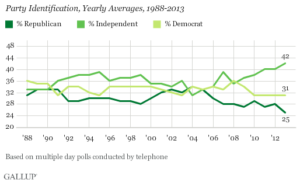 Earlier this year, the Oklahoma Ethics Commission proposed a change in campaign contributions. Under their proposal, the family restriction would be removed. This is great improvement as current law means a married couple can only give half as much as their unmarried friends.
Earlier this year, the Oklahoma Ethics Commission proposed a change in campaign contributions. Under their proposal, the family restriction would be removed. This is great improvement as current law means a married couple can only give half as much as their unmarried friends.
However, the other suggestion is something we can’t agree with. The other proposal is to change the current $5,000 per election cycle contribution limit to a $2,600 limit per election limit, meaning $2,600 for the primary, $2,600 for the run-off, and $2,600 for the general election. This proposal will create lopsided elections and disproportionately harm Independent candidates.
Thanks to Brian Altenhofel, we now learn about a 10th Circuit Court ruling that invalidates a similar law in Colorado (PDF). Any ruling from the 10th Circuit applies to Oklahoma as the state falls under its jurisdiction.
In Colorado, the law was that contributors could donate $200 to the campaigns of state candidates, but the law provided that major party candidates could get an additional $200 because they participated in a primary. However, the law was structured in such a way that the candidate doesn’t even have to participate in a primary. So even if a Republican or Democratic candidate was unchallenged in their party, they could still collect for the primary they didn’t participate in. However, the law provided no such additional contributions for minor party, unaffiliated or write-in candidates. This means the latter candidates could only get $200 per contributor while their Republican and Democratic competition could collect $400.
The district court did not question the fundamental nature of this right. Instead, the court reasoned that Colo. Rev. Stat. § 1-45-103.7 had not treated individuals contributing to Ms. Curry any differently than the individuals contributing to the Republican and Democratic candidates. This reasoning is incorrect. After the primary, a supporter of Ms. Curry could give her only $200. At the same time, others could contribute $400 each to the Republican and Democratic candidates, and the candidates could spend that money in the general election. In this way, the statute treated contributors differently based on the political affiliation of the candidate being supported. And by treating the contributors differently, the statute impinged on the right to political expression for those who support Ms. Curry or other nominees who are unable to obtain funds prior to nomination.
As a result, we conclude that the statutory classification impinged on a fundamental right.
Colorado had attempted to argue that such contribution limits were in place to fight corruption. However, the court did not see it that way.
The Defendants rely solely on the State’s interest in preventing corruption or the appearance of corruption. This interest is sufficiently important. See Buckley v. Valeo, 424 U.S. 1, 67-68 (1976) (per curiam). But this interest has little to do with Colorado’s statutory distinction among contributors.
In evaluating the connection to the statutory distinction, we must determine whether it is closely drawn to advance the State’s interest in preventing corruption or the appearance of corruption. We conclude that the means chosen are ill-conceived to advance these interests.
The statutory classification might advance the State’s asserted interest if write-ins, unaffiliated candidates, or minor-party nominees were more corruptible (or appeared more corruptible) than their Republican or Democratic opponents. But the Defendants have never made such a suggestion. In the absence of a link between the differing contribution limits and the battle against corruption, the means chosen are not closely drawn to the State’s asserted interest.
So if the law does not protect against corruption and results in hindering the ability of unaffiliated, minor party and write-in candidates’ to raise funds, then what is the purpose of the law? The court could find no reason.
We do not suggest that the constitution would forbid any contribution limits based on an election cycle. But here the State of Colorado has created different contribution limits for candidates running against each other, and these differences have little to do with fighting corruption. Indeed, even now, the Defendants have failed to articulate how the statutory classification advances Colorado’s interest in preventing corruption. Thus, we conclude that the statutory classification violates the right to equal protection for individuals wishing to contribute to write-ins, unaffiliated candidates, and minor-party candidates when each candidate runs unopposed for the nomination.
So under this ruling, Oklahoma should be very wary of making any changes to the contribution limits that would fall afoul of this court ruling. So we welcome the removal of the family restriction and would even welcome a lower cap. However, anything that creates lopsided elections as Colorado’s law and the Ethics Commission’s proposal do would be unconstitutional under this ruling.










